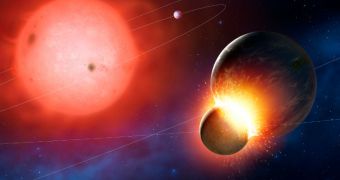A recent astronomical study has revealed four white dwarf-class stars tearing apart and consuming just as many rocky extrasolar planets very similar to Earth. The discovery points at what might happen in our own solar system, when the Sun reaches the end of its main sequence.
For G-type yellow dwarf stars like our own, the end of the main sequence implies the expansion of the outer layers of their atmosphere. This transforms them into red giants. After this stage of their evolution is completed, they shed the outer atmosphere, and retain only a helium-burning nucleus.
This remnant is commonly known as a white dwarf. As the star undergoes this evolution, it significantly affects any planets in its orbit. What astronomers at the University of Warwick saw with the Hubble Space Telescope was one of many potential scenarios that accompany the demise of stars.
The science team says that the four white dwarfs they observed are surrounded by debris fields that have a chemical composition very similar to that of rocky worlds like our own. A total of 80 stars in this class were investigated for this study, Space reports.
“What we are seeing today in these white dwarfs several hundred light-years away could well be a snapshot of the very distant future of the Earth,” a statement from study leader Boris Gänsicke reveals. He holds an appointment as a professor in the University of Warwick Department of Physics.
All white dwarfs analyzed in this study were located within a few hundred light-years of the Sun, therefore in our cosmic backyard. Some of them may have even formed from the same stellar nursery that gave birth to our parent star.
According to the Hubble data, the four most common elements detected in the debris field were oxygen, magnesium, iron and silicon. These chemicals make up around 93 percent of our planet. Additionally, the disks only revealed small amounts of carbon, which is also in tune with theories.
Astronomers interpreted the new data as suggesting that each of these four white dwarfs had at least one rocky, Earth-like exoplanet in orbit, which they destroyed as they exhausted their hydrogen fuel, and began the complex process of switching to helium fuel.
“As stars like our sun reach the end of their life, they expand to become red giants when the nuclear fuel in their cores is depleted,” Gänsicke explains.
“When this happens in our own solar system, billions of years from now, the sun will engulf the inner planets Mercury and Venus. It's unclear whether the Earth will also be swallowed up by the sun in its red giant phase – but even if it survives, its surface will be roasted,” he concludes.
Details of the work will appear in an upcoming issue of the esteemed journal Monthly Notices of the Royal Astronomical Society.

 14 DAY TRIAL //
14 DAY TRIAL //